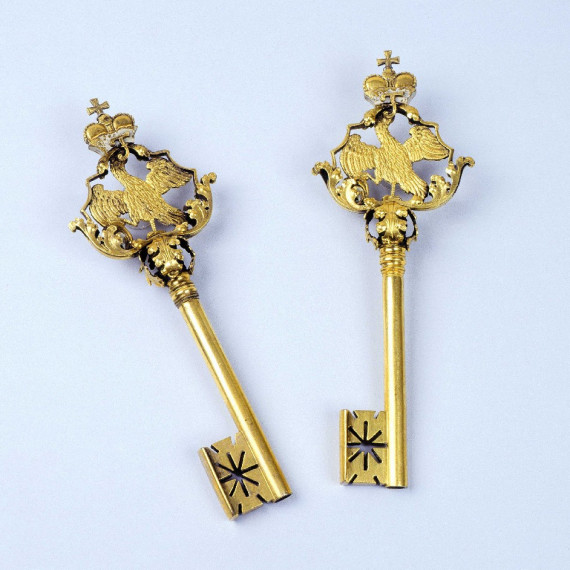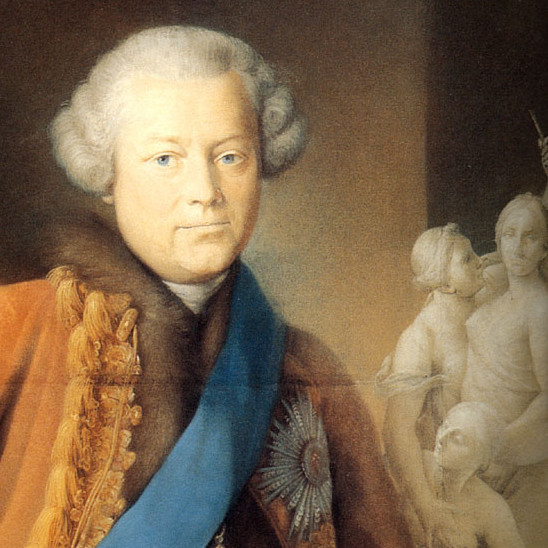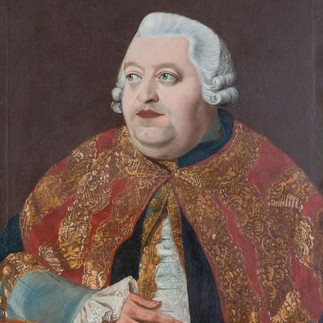Erlangen – University Town
 Ceremonial keys to the university
Ceremonial keys to the university
Bayreuth (?), 1742/43
The decorated key handles carry the Margrave's heraldic and name symbols: a standing eagle beneath the initial 'F' and the princely crown. At the university's inauguration on 4th November 1743, Margrave Friedrich ceremonially handed this pair of keys over to Prorector Roßmann.
The founding of Erlangen University goes back mainly to the then sovereign, Margrave Friedrich. Apart from his desire to go down in history as a patron of the sciences, he also expected the project to have economic benefits and deliver him greater influence over the education of his civil servants, clergy, and teachers.
After an attempt to establish the University in the Margravial seat of Bayreuth had failed on account of conflict between the student body and the garrison in 1742, it was moved to Erlangen, where suitable premises had become available due to the recent closure of the local knight academy.
The university was directly subordinate to the sovereign, who held the title of Rector Magnificentissimus. As a kind of 'state within the state', it had its own civil code and jurisdiction over disciplinary and simple criminal matters.
In 1743, the year of its foundation, only 64 students were enrolled at the university, compared to the 16 professors teaching them. During the remainder of the 18th century, student numbers settled at around 200. This gave Erlangen a middling position in the German university landscape.
A dedicated ensemble of buildings for the university did not develop until the 19th century.
The copper engraving by Franz Michael Regenfuß, 1744, shows the ceremonial procession on its way to the Neustädter Kirche ('New Town Church'), passing the buildings of the former knight academy, which housed the university from 1743 to 1825.

Margrave Friedrich of Brandenburg-Bayreuth-Kulmbach (around 1756)
Francesco Pavona
Pastel on cardboard (reproduction)
Erlangen, art possession of the University No. 393
Margrave Friedrich ruled the Bayreuth territory from 1735 to 1763. The University of Erlangen was also founded during his time. In the Austrian hussar uniform, with the Danish elephant and Black Eagle order on his chest, he presents himself as an art-loving sovereign by pointing to the allegories of sculpture, architecture and painting.
The foundation of the university of Erlangen counts among Margrave Friedrich's most far-reaching decisions. Later Chancellor Daniel de Superville is regarded as the driving force behind the project; the founding of the university also enjoyed the moral support of well-educated Margravine Wilhelmine, who was Prussian King Frederick the Great's sister.

Professor Johann Paul Reinhard (before 1779)
Oil on canvas
Erlangen, art possession of the University No. 452
Loan from the University of Erlangen-Nuremberg
Johann Paul Reinhard, ordinary professor at the University of Erlangen since 1752, taught as a professor of history from 1767 until his death. His town chronicle is one of 18th-century Erlangen's most important historical sources. This portrait shows Reinhard in the Prorector's scarlet robe, complete with ceremonial staff.
< Previous chapter | Next chapter >
